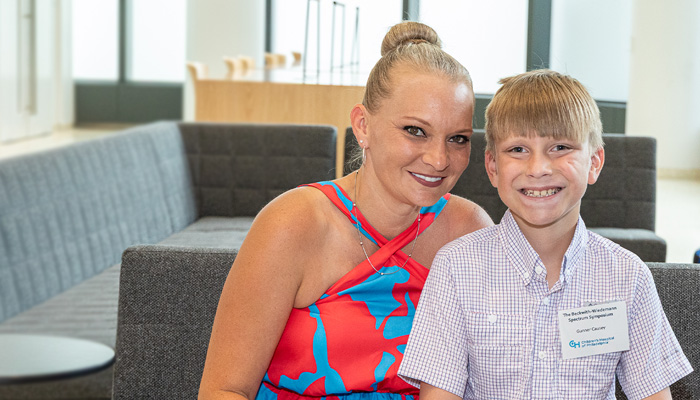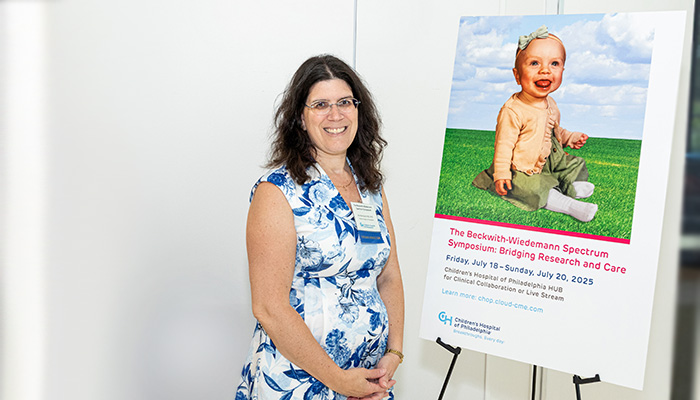HOW CAN WE HELP YOU? Call 1-800-TRY-CHOP
In This Section
CHOP Researchers Shed Light on Epigenetic Causes of Overgrowth Syndromes

CHOP researchers are exploring the molecular underpinnings of Beckwith-Wiedemann syndrome (BWS) to better treat patients like Gunner, who attended the BWS symposium earlier this year.
Little was known about the rare epigenetic disorder Beckwith-Wiedemann syndrome (BWS), characterized by overgrowth throughout the body and an increased risk of childhood cancer, when Jennifer Kalish, MD, PhD, launched a voluntary patient registry for BWS research at Children's Hospital of Philadelphia in 2014.
A decade later, Dr. Kalish and her collaborators are answering new, critical questions about BWS and other overgrowth disorders using samples and data from CHOP's registry — the only one of its kind in the world.
"At CHOP, we had multiple referral groups and areas of expertise, but there were many lingering questions," said Dr. Kalish, Director of CHOP's BWS Program of Excellence. "How do you diagnose BWS when you have a spectrum of clinical features? How do you manage it? What's driving the overgrowth, and what's driving the cancer risk in these patients?"
Most recently, researchers in the Kalish Laboratory published findings in Communications Biology, along with researchers from the Division of Genetics and Division of Oncology at CHOP and the Department of Pediatrics at the University of Pennsylvania. These findings shed new light on the possible underlying mechanisms of tissue overgrowth and cancer predisposition in BWS.
Additionally, new funding from the National Institutes of Health is allowing Dr. Kalish and her colleagues to uncover the specific cell types and cell interactions that cause severe tongue overgrowth in some BWS patients. It is an entirely new line of research for the Kalish Lab.
"Currently, care management for patients with BWS [includes] screening for tumors, but we don't know how to stop that transition to cancer," Dr. Kalish said. "We are the first group using molecular approaches in human samples to try to understand the potential mechanisms that could be driving the overgrowth and causing cancer."
Understanding the BWS-Liver Connection

In 2014, Jennifer Kalish, MD, PhD, launched a voluntary patient registry for BWS research at CHOP — the only one of its kind in the world.
BWS is an epigenetic disorder caused by changes in a specific part of chromosome 11 (11p15), which leads some tissues in the body to grow too much, especially in the liver. These changes increase the chances that a patient with BWS will develop liver cancer, specifically a type called hepatoblastoma.
While an estimated 25% of patients with BWS develop cancer, according to Dr. Kalish, researchers do not fully understand the molecular cues that lead tissue overgrowth to develop into tumors.
Previous research from the Kalish Lab showed that liver tissue near BWS tumors, as well as the tumors themselves, had signs that suggest a higher risk of cancer. Infants with BWS often have higher levels of a protein called alpha-fetoprotein (AFP), which is normally made by the liver. This suggests that livers in BWS patients are more active than usual.
Based on these findings, Dr. Kalish and colleagues created a detailed map of liver tissue in BWS children to understand the disease at a detailed, single-nucleus level. They used single-nucleus RNA sequencing to study the cells in BWS livers and identify which types of cells were most common when compared to tissue samples from healthy patients. To confirm their findings, the researchers also sequenced lab-grown BWS liver cells from induced pluripotent stem cell lines.
The research team found that the types of cells in the livers of BWS patients were similar to those in non-BWS livers. However, certain pathways related to fat and lipid metabolism, along with the signaling of a protein called PPARA, showed more activity in BWS liver cells compared to normal liver cells. Further testing showed the that the BWS liver cells had fewer fat droplets and were burned fat more quickly compared to controls.
When the researchers compared the lab-grown BWS liver cells to control cells, they found similar changes.
The findings suggested that the changes in metabolism could be driving the transition to cancerous cells in BWS livers.
"Now we have a pathway to target," Dr. Kalish said. "The next step of our research is to study —and try to prevent — the transition from liver cells into cancer."
Mechanisms of Macroglossia
In addition to cancer, severe tongue overgrowth (macroglossia) is another common symptom of BWS — affecting up to 85% of patients — which can lead to airway obstruction and significant feeding difficulties.
Surgical resection is currently the only treatment for macroglossia, which can be accompanied by its own set of side effects, including risk for lingual nerve injury and infection.
Two critical genes altered in BWS may play a role in tongue overgrowth: cyclin-dependent kinase 1C and insulin-like growth factor 2. However, the exact signaling pathways causing macroglossia have not been defined.
"There's been no in-depth, molecular analysis of BWS tongues," Dr. Kalish said.
With new funding from the NIH and access to over 100 patient tongue samples, researchers in the Kalish Lab will use single-cell sequencing to uncover how the genetic changes seen in BWS lead to distinct BWS tongue traits based on the cell composition, expression, and function of the disease's genetic subtypes.
Dr. Kalish envisions that this new research focus will lead to the development of noninvasive, targeted treatments for BWS and other conditions.
"If we could treat a baby without surgery — and prevent the overgrowth that's affecting speech, feeding, and breathing — that's our ultimate goal," she said.